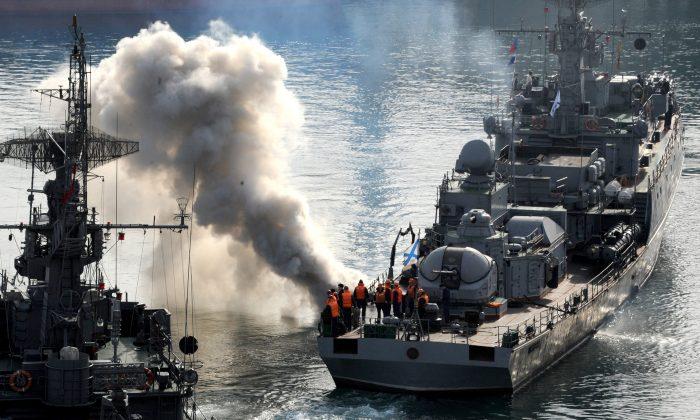Russian missile makers have recently tested a new weapon they hope to sell to China. The newly developed Russian missile is designed to attack naval targets, and well suited for attacks against U.S. carriers.
According to Aviation Week and Space Technology, flight testing is underway on a variant of Russia’s Raduga Kh-59M (NATO AS-18 Kazoo) anti-ship missile. Flight trials of the modified Kh-59 began in 2004, using a SU-30MK2 aircraft already sold to Beijing.
The Chinese naval (PLAN) air arm began taking delivery of the first batch of 24 SU-30MK2s strike-fighters in mid-2004. The newly modified missile has been fitted with an active radar seeker, advanced guidance systems and a special computer interface allowing it to use targeting data from the Su-30MK2 fighter.
The modified Kh-59 missile is fitted with a Saturn 36MT turbojet engine and its range has been extended to 186 miles or 288 KM.
Missile Story
“The Raduga Kh-59MK is a serious story that is just beginning,” stated Richard Fisher, Vice President, International Assessment and Strategy Center.
“It is significant that it is being tested on the prototype of the Chinese version of the Su-30, a strong indication that this 288 KM range active-guided anti-ship missile will soon be joining PLA Naval Air Force Su-30MKK2 units,” stated Fisher.
“It was originally pitched as the weapon to accompany the Su-30MKK3, which features a new radar from a bureau in competition with the normal Sukhoi radar provider. The Su-30MKK3 program died a quiet death last year, according to Russian sources with vested interests in its demise. The Kh-59MK, however, will survive, and Raduga officials say it will be ready for export in 2006,” noted Fisher.
PLAN forces are very familiar with Russian missiles. China has already purchased the Zvezda Kh-31A (AS-17 Krypton) air-launched anti-ship missile from Moscow. The ramjet powered Kh-31 can reach a top speed of Mach 2.8. The PLAN is currently working on manufacturing the Kh-31 and has already introduced a modified version, the KH-31P, with a range in excess of 100 miles.
The PLAN has acquired several Russian Sovremenniy destroyers armed with the latest versions of the Raduga 3M80 Moskit anti-ship missile (NATO SS-N-22 Sunburn). The Moskit can cruise at 3 times the speed of sound and can be armed with a 200-kiloton nuclear warhead. Each PLAN Sovremenniy class destroyer is armed with eight Sunburn missiles.
The addition of the subsonic Kh-59 to the PLAN aviation inventory will give it deadly combination of weapons that can pin down naval targets at long range and then swiftly attack them from a variety of directions. The build up of Chinese naval attack forces has not escaped notice in the west.
Chinese Naval Build-up
“This adds yet another layer to China’s building anti-carrier forces, which will soon include 8 Russian NPO-Machinostroyenia electro-optical and radar satellites; 12 Kilo submarines- 8 armed with 220km range CLUB anti-ship missiles; Xian JH-7A fighter-bombers armed with Russian Kh-31 anti-ship missiles; and according to late reports, an eventual total of 6 Sovremenniy class missile destroyers,” said Fisher.
In addition, Russia and China have reached an agreement covering the purchase of 100 Klimov RD-93 engines for the Chengdu FC-1 strike fighter jet. According to the Russian financial daily Kommersant, the deal reportedly bars re-export of the engines.
The FC-1 is being developed by CAC-1, formerly Chengdu Aircraft Corp., with partial funding by Pakistan. The FC-1 draws its design lineage from the Super-7 fighter program, a cooperative development between Chengdu and then Grumman Corp. The agreement was signed in 1988, but fell apart after Beijing’s violent reaction to the Tiananmen Square demonstrations in 1989.
However, the FC-1 incorporates many features from the U.S. F-16 Fighting Falcon design. The F-16 features appeared during the 1990s after Pakistan transferred a single F-16A fighter to China in exchange for DF-11 missile technology.
Russia has also contributed to the FC-1 project. The FC-1 reportedly incorporated several features of the now defunct MiG-33 lightweight fighter project rejected by the Russian Air Force. The Russian MiG design bureau dedicated several teams of engineers to the Chinese fighter after the fall of the Soviet Union. A single modified MiG-29 engine, the Klimov RD-33, dubbed the RD-93, powers the FC-1.
New Jet Fighter for Beijing or Islamabad?
“There appears to be some confusion about the ultimate destination of the 100 Klimov RD-93 engines for the Chengdu FC-1 fighters,” stated Richard Fisher.
“Most sources note China wants to sell them to Pakistan, which has a stated requirement for 150, but the Russians in several articles say they will not allow flat resale of the engines. The reported reason is opposition by India, which buys much more Russian weapons than Pakistan,” noted Fisher.
“Chengdu, however, has tried hard to sell the FC-1 as the successor to the PLA’s Chengdu J-7 fighters, but there have been no solid reports that this indeed will happen. The third alternative possibility is that China will ‘produce’ its own version of the RD-93 in such a way as to absolve the Russians of any guilt from its sale to Pakistan. This story is not over,” said Fisher.
The continuing arms sales by Moscow are a growing concern to Washington and its Asian allies. The Chinese arms build up is clearly aimed at challenging the U.S. armed forces in Asia and in particular the U.S. Navy in the Pacific.
However, future weapons purchases remain unclear because of Beijing’s desire to acquire more advanced armament from the west. For example, the pending decision by the European Union to sell arms to China may very well be more damaging to world peace than the current weapons deliveries from Moscow.
“The Russians badly need the hard currency that their deteriorating arms industry can provide, but do not help their own defense posture on their eastern flank by selling them to the Chinese,” stated John Shaw, former deputy under secretary for international technology security in the George W. Bush Defense Department.
“Look for lots of sales of last generation equipment, but recognize that others can provide upgrades that are better than the state of the art in Russia-for a fat fee,” concluded Shaw.





Friends Read Free